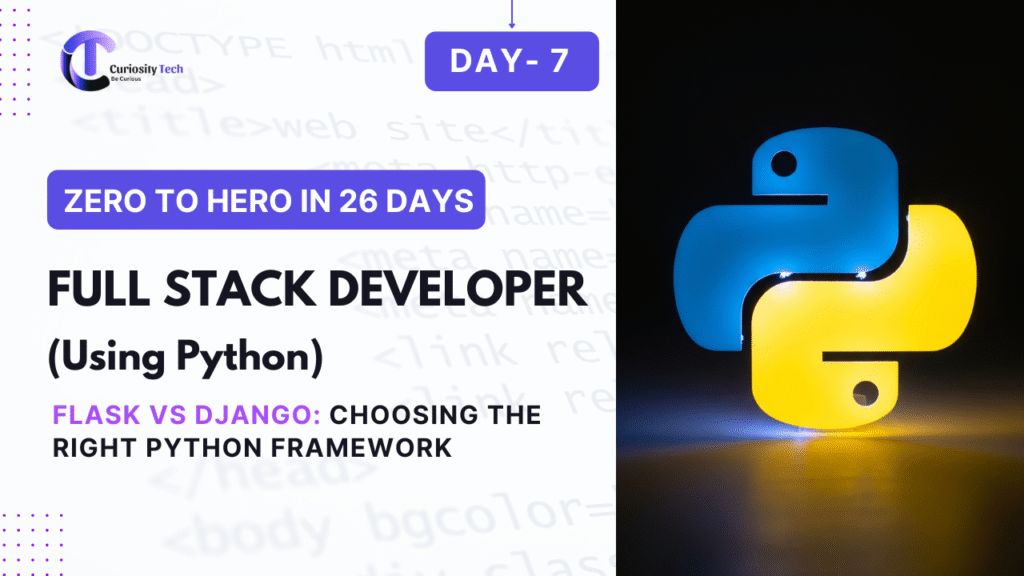Description
When stepping into Python full stack development, one of the first choices you’ll face is whether to use Flask or Django. Both frameworks are powerful, widely adopted, and industry-proven, yet they serve slightly different needs. Picking the wrong one can make your project more complicated than it needs to be. In this blog, we’ll compare Flask and Django in detail so you can decide which framework aligns with your project, career goals, or startup idea.
1. Why Framework Choice Matters?
Imagine building a house. The tools and construction method you choose will determine not only how fast you can build but also how scalable and secure it will be. The same applies to web frameworks: Flask and Django are the toolkits that decide how quickly you can move from idea to deployment.
At CuriosityTech, we guide students through hands-on projects in both Flask and Django so they understand strengths, limitations, and real-world applications before committing to one.
2. Overview of Flask and Django
Flask – The Lightweight Microframework
- Minimalist, flexible, “do-it-yourself” approach.
- Great for small-to-medium apps, prototypes, or when you want full control.
- Often chosen for startups and microservices.
Django – The Full-Stack Framework
- Batteries-included, comes with ORM, authentication, admin panel, and more.
- Best for large-scale projects where structure and speed matter.
- Often chosen by enterprise-level applications like Instagram and Pinterest.
3. Feature Comparison Table
| Feature | Flask | Django |
| Type of Framework | Microframework (minimalist) | Full-stack “batteries-included” |
| Learning Curve | Easier to start, more decisions needed | Steeper initially, but structured |
| Built-in Features | Very few (requires extensions) | Many (ORM, Admin, Auth, Security, etc.) |
| Flexibility | High – you decide architecture | Medium – follows Django conventions |
| Performance | Faster for small apps | Optimized for large-scale apps |
| Use Cases | APIs, Prototypes, Microservices | Full apps, E-commerce, Social Networks |
4. When to Choose Flask?
- Building a quick prototype.
- Developing REST APIs with minimal overhead.
- Projects where custom architecture is required.
- Startups experimenting with MVPs (Minimum Viable Products).
Example: Flask Route
from flask import Flask
app = Flask(__name__)
@app.route(‘/’)
def hello_world():
return ‘Hello, World! This is Flask.’
if __name__ == ‘__main__’:
app.run(debug=True)
5. When to Choose Django?
- Large applications with many built-in features.
- Projects that require user authentication, admin dashboards, or ORM out of the box.
- Teams that prefer structure and convention over freedom.
Example: Django View
from django.http import HttpResponse
def hello_world(request):
return HttpResponse(“Hello, World! This is Django.”)
6. Hierarchical Diagram: Flask vs Django Decision Tree

7. Real-World Use Cases
- Flask Examples: Netflix uses Flask for internal APIs, Lyft uses Flask for microservices.
- Django Examples: Instagram, Pinterest, and Mozilla rely on Django for full-scale apps.

9. CuriosityTech Insight
We’ve seen learners at CuriosityTech start with Flask for small projects like a to-do app or portfolio site, then transition to Django for enterprise simulations such as e-commerce platforms. This hands-on progression builds confidence and portfolio strength.
10. Conclusion
The Flask vs Django debate is not about which framework is better but which is better for your context. If you want freedom and flexibility, Flask is your go-to. If you need power and structure, Django is the clear winner. The best developers — like those trained at CuriosityTech in Nagpur and across digital platforms — often learn both, ensuring they can adapt to any



